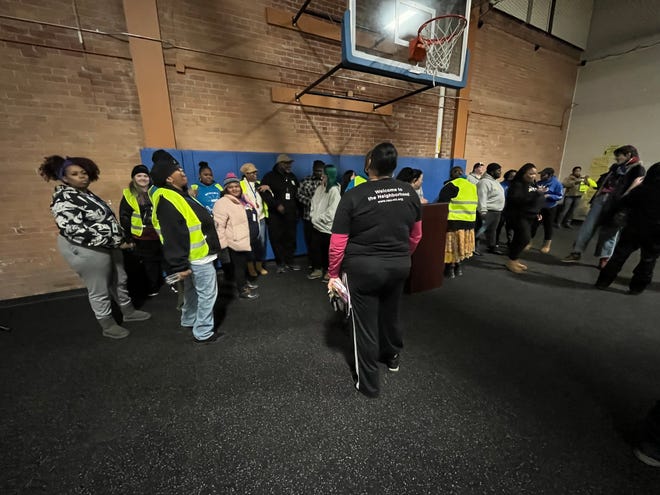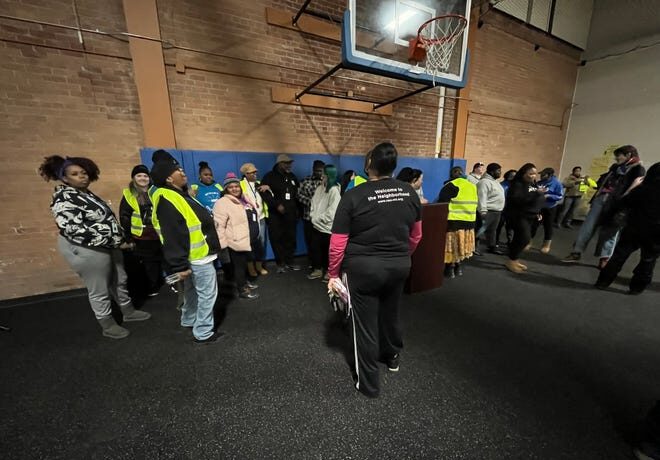Detroit — Despite freezing temperatures that made it hard to locate people living on the streets, advocates for the homeless searched southeast Michigan communities last month in an effort to count those in need to draw in critical federal funds.
Volunteers joined the Homeless Action Network of Detroit for the point-in-time count on Wednesday night in Detroit. About 120 volunteers, fanned out across the Motor City, spreading out in teams, canvassing several neighborhoods to survey people facing homelessness, leaders said.
Volunteer Ronnika Harris of Detroit is careful about approaching homeless people too stridently to seek information about their situations. She wants them to trust that she has their interests in mind.
“Just being welcoming, being open and not judgy,” Harris said of her approach. “Explaining why we’re doing what we’re doing and giving them as much information that we can to get them to open up. It’s not always easy, but people see and feel your heart, so if you display the right heart, usually they will share their stories.”
Braving the cold in 2021 to find unsheltered people was worth it, Harris said, even though her team of three only found two people. This year she hopes for better results with the Homeless Action Network of Detroit.
“The first time I participated was two years ago and it was still during COVID-19…and we didn’t find a lot of people outside,” Harris said of the four-hour search. “So I’m just hoping to be able to engage more people this year and see if we can get them in shelter.”

The bi-annual count, a requirement of the U.S. Department of Housing and Urban Development, is designed to collect information to draw federal funding for Michigan’s largest city. It takes place the last 10 days of January.
Street outreach workers, homeless service providers and volunteers collected information about those living on the streets, including their stories, and offered to provide them with shelter, leaders said. Volunteers carried new winter hats and scarves, thermal blankets, gloves and mittens, socks and personal hygiene kits and handed them out.
“Ultimately, this is data we report to HUD, and it helps all communities across the country, which are doing the point-in-time count this month,” said Amanda Sternberg, a performance management analyst for Homeless Action Network of Detroit. “HUD uses this data from across the country to report to Congress, to set funding levels, so it’s really data that the federal government uses to drive funding allocations.”
Sternberg said the information helps local governments and organizations in Detroit to understand such needs as mental health and substance abuse services, or affordable housing.
In a 2021 report, the Homeless Action Network of Detroit and the Detroit Continuum of Care, a year-round planning body of stakeholders working to end homelessness in Detroit, Hamtramck and Highland Park, found more than 5,600 people facing homelessness in Detroit.
The count, Sternberg said, happens at night because they’ve found someone in the streets at night during the winter likely has no place to go.
“The one thing that I hear often from our street outreach workers is it takes a lot of time to build trust with people who have been staying unsheltered for a long time,” she said. “So we have staff day-in-and-out doing this hard work every day, building trust with folks and getting them to engage in services.”
In Detroit, the weather on Wednesday was warmer compared to past count periods, which volunteers were hoping would affect their ability to spot unsheltered populations. Temperatures on Wednesday were above average around 41, according to National Weather Service records.

Richard Monocchio, principal deputy assistant secretary at HUD, said every year, housing programs are awarded funds and resources from the federal government based on innovative programs that seek to serve homeless populations.
Programs are those that “build permanent supportive housing … build transitional housing for the homeless, they run shelter and food programs for homeless people, they run job training and placement programs … and critically provide rental assistance,” Monocchio said.
HUD announced in October that it allocated 70,000 housing vouchers to local public housing authorities through the Emergency Housing Voucher program to help individuals and families who are homeless, at-risk of homelessness and other destabilizing situations, according to its website.
The Biden administration awarded $3.16 billion in homelessness assistance to communities across the nation, according to a news release HUD on Monday.
“This Point-in-Time Count is sort of symbolic and important for everything we do at HUD in the homeless space,” Monocchio said, adding that 400 counts occurred throughout the nation in January. In Michigan, 20 communities participated in the count, he said.
Meanwhile, in Macomb County, the state’s third most populous county, dozens of volunteers conducted a count on Jan. 28 with Macomb Community Action, a member of a national network of organizations that helps people move from poverty to economic stability.
Volunteers were assigned ZIP codes and “hot spots” such as parks and bus stops to gather information, including gender, race, ethnicity, veteran status, age and disabilities. Volunteers sought to identify if a person was “chronically homeless” or was experiencing homelessness due to domestic violence or substance use, leaders said.
Macomb County Executive Mark Hackel described the count as essential.
“It provides support to individuals in our society that sometimes get left behind,” Hackel said last month.
Food, hand warmers, winter clothing, hygiene kits, blankets, fast-food gift cards and bus tickets were handed out, Macomb Community Action leaders said. Local charities donated the items.
Kristin DeFranco, program coordinator for housing resources at Macomb Community Action, said in 2021, the numbers stayed stagnant from the previous count of those experiencing homeless.
“The pandemic time was difficult because a lot more people were becoming homeless due to evictions and job loss,” DeFranco said. “Macomb County in particular, the numbers haven’t changed. If anything we need more resources for the homeless.”














